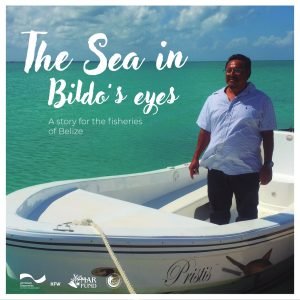
Introduction
An effective way of attending the different problems that threaten the Mesoamerican Reef is through the development of an interconnected and functional regional network of coastal and marine protected areas (MPAs). If properly managed, the resulting network, the reef’s backbone, will protect fish populations, diverse habitats, spawning aggregation sites, aquatic resources, forest resources, recreation opportunities and development and growth possibilities for the ecoregion.
Well-managed protected areas regulate access to fisheries, protecting both target and non-target species and allowing populations to either recover or, at a minimum, maintain sustainable levels required to support community livelihoods. Additionally, the inclusion of coastal areas within a regional network preserves sea grass beds and mangroves, providing critical reproductive habitat for endangered manatees, turtles, and other species. This coastal habitat also curbs land erosion and filters incoming water, serving as an effective buffer zone between the watershed and the reef. Finally, within the framework of protected areas we are able to reduce the impacts of climate change by applying proper management practices and protecting resilient reefs.
To select the priority areas, MAR Fund facilitated a process that included the participation of different actors from the four countries. The methodology that was designed for this purpose was applied initially through four workshops to obtain the national priorities. These results were then analyzed at a regional workshop, in which the number one priorities for the region were defined. The initial network of 14 areas are included in the map.
The Project Conservation of Marine Resources in Central America focused on implementing effective, long-term conservation mechanisms in nine areas. Support was also provided for planning, monitoring, updated management plans, control and surveillance systems, infrastructure and equipment, among others, in order to optimize the work performed by the administrators of the areas.
A series of activities defined by each protected area were also supported, with the aim of achieving sustainable use of the areas’ resources, assets and services. These included, for example, the following: codes of conduct for various extractive activities, incentive programs to involve communities in conservation, co-management of conservation zones together with users, strategies for recycling solid waste, mangrove reforestation, environmental education campaigns, sustainable fisheries and responsible tourism.
The intervention logic of the Project focused on improving the conservation and sustainable use of the biological diversity found in the nine selected CMPAs.
This approach combines three strategies:
- Conservation of coastal and marine ecosystems.
- Better management and sustainable use practices of coastal and marine resources.
- Small grants and implementation of mechanisms for the exchange of knowledge and experience among the Project groups, for example administrators of the CMPAs, or among users of the resources.
Project Objective Indicators:
- Indicator 1:There is no increase in the financial gap in all of the CMPAs included in the Project.
- Indicator 2:Management Plans are updated and under implementation in 100% of the CMPAs included in the Project.
- Indicator 3:The CMPAs included in the Project have natural resource used plans under implementation.

Phase I
This project was supported by the German Government, through KfW, for a total amount of €5 million that were invested in four priority coastal and marine protected areas within a five-year period.
The main objective of the Project is to contribute to the consolidation of the coastal and marine protected areas, the protection of biological diversity and the sustainable use of its components, while increasing the economic well-being and improving the quality of life of the resident populations.
The area of the Project is the Mesoamerican Reef System, shared by Mexico, Belize, Guatemala and Honduras. The following priority coastal and marine protected areas (CMPAs) are the focus of the main Project investments:
- Yum Balam Flora and Fauna Protection Area, México.
- Port Honduras Marine Reserve, Belize.
- Punta de Manabique Wildlife Refuge, Guatemala.
- Sandy Bay West End Special Marine Protection Zone, Honduras
a) Yum Balam Flora and Fauna Protection Area, Mexico.
b) Port Honduras Marine Reserve, Belize.
c) Punta de Manabique Wildlife Refuge, Guatemala.
d) Sandy Bay-West End Special Protection Area, Honduras.
• Sandy Bay-West End Special Marine Protection Zone, Honduras
![]() o Systematization of experiences related to the Marine Infrastructure Program in the Sandy Bay West End Special Marine Protection Zone, Roatan, Honduras
o Systematization of experiences related to the Marine Infrastructure Program in the Sandy Bay West End Special Marine Protection Zone, Roatan, Honduras
![]() o Systematization of experiences related to the Marine Water Quality Monitoring Program in Sandy Bay West End Special Marine Protection Zone, Roatan, Honduras.
o Systematization of experiences related to the Marine Water Quality Monitoring Program in Sandy Bay West End Special Marine Protection Zone, Roatan, Honduras.

Phase II
Just as in Phase I, the German Government through KfW, also supported this phase for a total amount of €5 million that was invested in five priority coastal and marine protected areas within a five-year period.
This phase of the Project also contributed to the consolidation of the coastal and marine protected areas, the protection of biological diversity and the sustainable use of its components, while increasing the economic well-being and improving the quality of life of the resident populations.
The area of the Project is the Mesoamerican Reef System, shared by Mexico, Belize, Guatemala and Honduras. The following priority coastal and marine protected areas (CMPAs) are the main areas of investment for the Project at this phase:
- Manatee Sanctuary State Reserve, Bahía de Chetumal, Mexico.
- Corozal Bay Wildlife Sanctuary, Belize.
- South Water Caye Marine Reserve, Belize
- Sarstun River Multiple Use Area, Guatemala.
Turtle Harbour Rock Harbour Special Marine Protection Zone, Honduras
a) Manatee Sanctuary State Reserve, Bahía de Chetumal, Mexico
b) Corozal Bay Wildlife Sanctuary, Belize
c) South Water Caye Marine Reserve, Belize
d) Sarstun River Multiple Use Area, Guatemala
e) Turtle Harbour Rock Harbour Special Marine Protection Zone, Honduras

![]() Project Implementers meeting agenda 2013
Project Implementers meeting agenda 2013
Participants List
Meeting Participants List, August 2013 ![]()
General presentations
![]() Introduction of the Project “Conservation of Marine Resources in Central America”
Introduction of the Project “Conservation of Marine Resources in Central America”
![]() Rapid Evaluation of Management Effectiveness in the marine coastal protected areas of the MAR
Rapid Evaluation of Management Effectiveness in the marine coastal protected areas of the MAR
![]() Monitoring and Evaluation Manual of the Project
Monitoring and Evaluation Manual of the Project
Protected areas presentations
![]() Yum Balam Flora and Fauna Protection Area, México
Yum Balam Flora and Fauna Protection Area, México
![]() Port Honduras Marine Reserve, Belize.
Port Honduras Marine Reserve, Belize.
![]() Punta de Manabique Wildlife Refuge, Guatemala.
Punta de Manabique Wildlife Refuge, Guatemala.
![]() Sandy Bay West End Special Marine Protection Zone, Honduras.
Sandy Bay West End Special Marine Protection Zone, Honduras.
![]() Project Implementers Meeting Agenda 2015
Project Implementers Meeting Agenda 2015
Participants List
Meeting Participants List, April 2015 ![]()
Good Practices Presentations
![]() Communication as a management tool in APFF Yum Balam, Mexico
Communication as a management tool in APFF Yum Balam, Mexico
![]() Toledo Institute for Development and Environment (TIDE), PHMR, Belize
Toledo Institute for Development and Environment (TIDE), PHMR, Belize
![]() Setting up a support committee for the management of the area, RVSPM Guatemala
Setting up a support committee for the management of the area, RVSPM Guatemala
![]() Water Quality Monitoring and its dissemination to the Local Water Authorities, BICA Honduras
Water Quality Monitoring and its dissemination to the Local Water Authorities, BICA Honduras
![]() Marine Infraestructure, RMP Honduras
Marine Infraestructure, RMP Honduras
Regional Presentations
![]() CEMEC_Monitoring and Evaluation Center, CONAP
CEMEC_Monitoring and Evaluation Center, CONAP
![]() Connectivity in the Mesoamerican Reef
Connectivity in the Mesoamerican Reef
General Presentations
![]() 001_PPT 001 MAR Fund General_FINAL
001_PPT 001 MAR Fund General_FINAL
![]() 002_PPT 002 Memoria Institucional Fondo SAM
002_PPT 002 Memoria Institucional Fondo SAM
![]() 003_PPT 003 10-year Anniversary Update Feb 2016
003_PPT 003 10-year Anniversary Update Feb 2016
![]() 004_PPT 004 Ejercicio de Priorización de Áreas
004_PPT 004 Ejercicio de Priorización de Áreas
![]() 006_Doc PPT 006 Evaluaciones y Monitoreo
006_Doc PPT 006 Evaluaciones y Monitoreo
![]() 007_PPT 007 Management Efectiveness
007_PPT 007 Management Efectiveness
![]() 009_PPT Administrativa Encuentro Feb 2016
009_PPT Administrativa Encuentro Feb 2016
![]() 010_PPT 010 Coordination Meetings and visits
010_PPT 010 Coordination Meetings and visits
![]() 011_Doc PPT 011 Sostenibilidad
011_Doc PPT 011 Sostenibilidad









